What to See, Do, and Eat in Morelia
Morelia is a stunning city designated as a UNESCO World Heritage Site. As the capital of Michoacán, an agricultural state renowned for its exceptional regional cuisine, Morelia is particularly famous for its ice cream, carnitas, and Baroque architecture. We spent two days exploring the historical center, but it’s quickly become a favorite city of ours, and we can’t wait to explore more. Read on to discover what to see, do, and eat in Morelia.
Disclosure: Some links may be affiliate links where we receive a super-small commission at no additional cost to you if you click through and make a purchase. We call this our Chocolate & Churro Fund.
We arrived in Morelia, dropped off our bags, and headed into the historical center. The center is compact and laid out in a grid design which makes it easy to explore. Several museums and historical buildings are located near the Cathedral, but don’t miss the attractions by the aqueduct such as Callajon del Romance and Bosque Cuauhtémoc with its museums and bike paths.
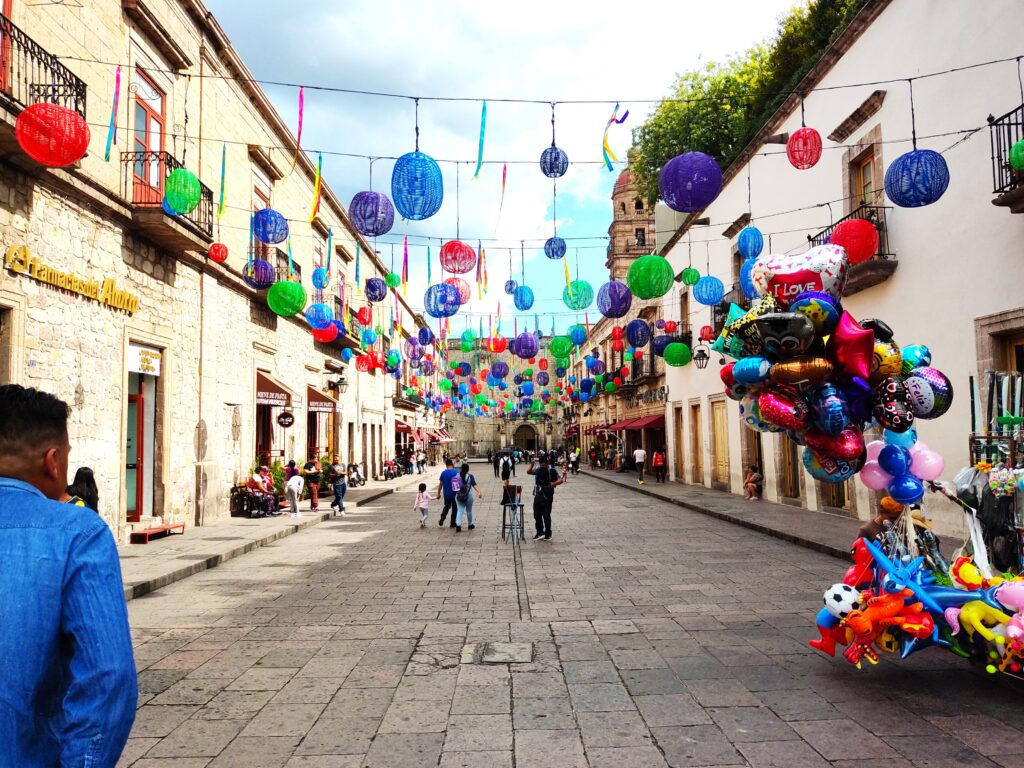
Brief History About Morelia
Since there weren’t any written records before the Spanish arrived, what little we know about the history of the region is based on human artifacts dating back to the 7th century. The Purépecha and other tribes established settlements around Lake Patzcuaro in the 12th century. In the 1520s, the Spanish arrived and took control of the area. Viceroy Antonio de Mendoza created a settlement in 1541 and named it Valladolid (after Valladolid in Spain). Between the 16th and 18th centuries, the town prospered and built several Baroque-style buildings and palaces that still stand today.
Valladolid was one of many cities that conspired against the Spanish in 1809 and 1810. After the Mexican War of Independence ended (1810-1821), the city of was renamed Morelia, in honor of José María Morelos y Pavón, a Catholic priest, statesman, and military leader born in Valladolid (Morelia).
Morelia Becomes a UNESCO World Heritage Site
Morelia was named a UNESCO World Heritage Site in 1991 because of its city plan, architecture, and historical figures. The historical center encompasses 249 monuments, many of which were built with the pink stone characteristic of the region. Most of the city was built between the 17th and 18th centuries and display Renaissance, Baroque, and Neoclassical elements that form what the artistic world likes to call “Baroque Moreliano”.
Miguel Hidalgo y Costilla and José María Morelos, two priests who led the independence effort of the Mexican people, studied at the San Nicolás College (now the Michoacán University of San Nicolás de Hidalgo, the oldest university in the Americas.
Fun Film Fact:
The 1958 film The Bravados starring Gregory Peck and Joan Collins was filmed in Morelia.
What to See and Do in Morelia
Morelia Cathedral
The first thing you have to see in Morelia is the Cathedral. Finished in 1744, it’s the only cathedral in Mexico that faces north (all the others face south). Despite lootings throughout the many wars, the cathedral still houses many artistic and religious paintings and relics. The twin towers and Baroque façade are illuminated every Saturday night with an impressive LED show and fireworks.
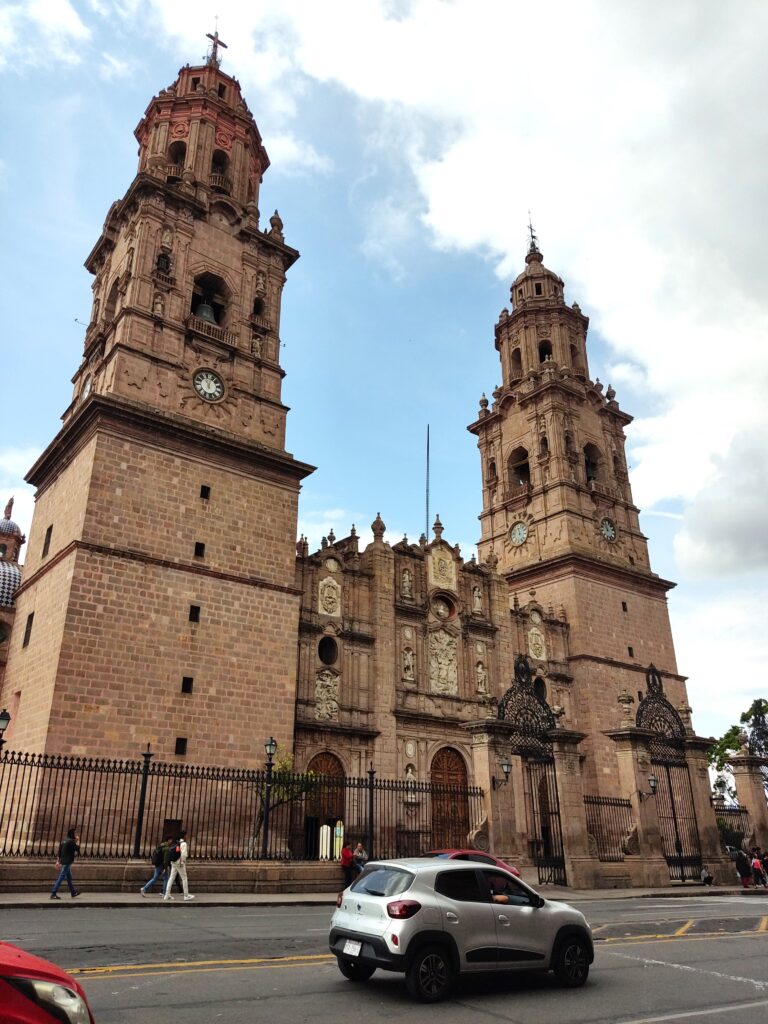
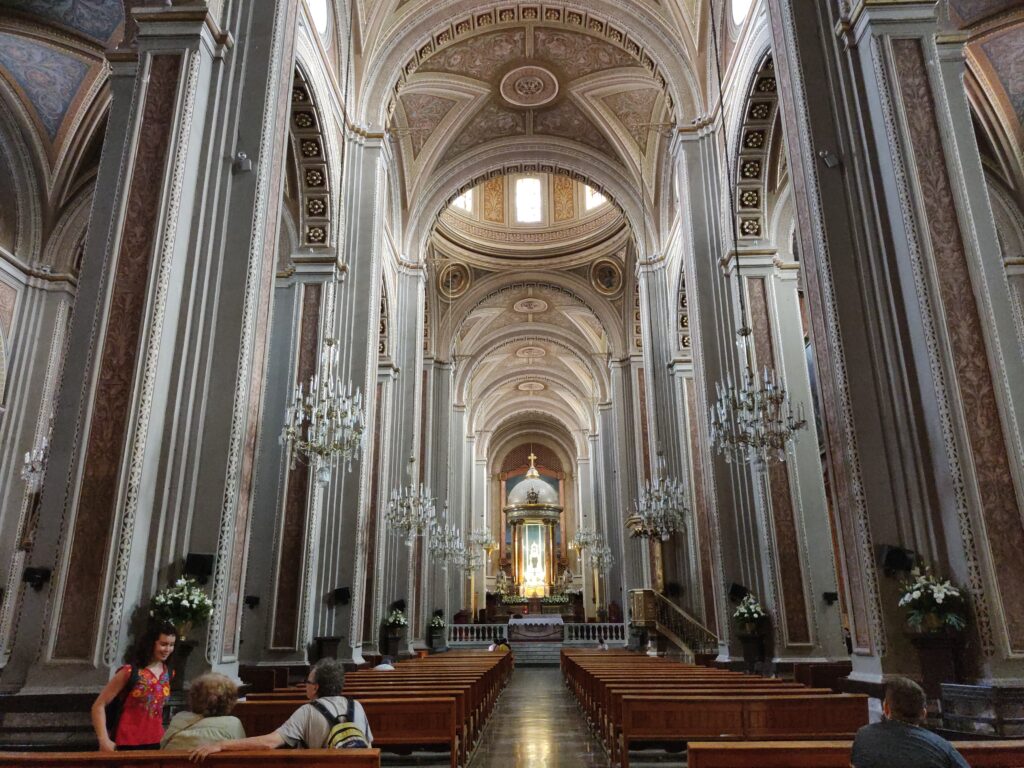
TRAVEL TIP
Stay at Cantera Diez Hotel Boutique for a fantastic view of the Saturday Night Light Show on the Cathedral above the crowd!
Plaza de Armas
To the west of the cathedral is Plaza de Armas, a tree-shaded park with the Morelia letters and a statue of Benito Juarez, the first and the only indigenous president of Mexico, who served from 1858-1872.
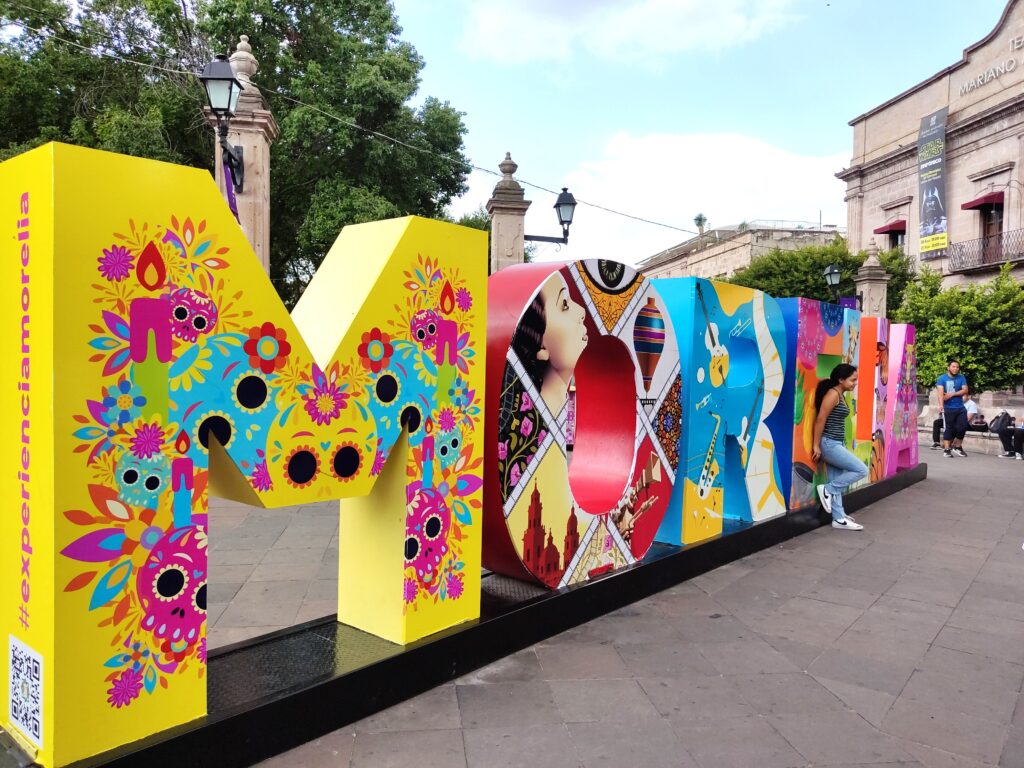
Palacio de Gobierno
This 18th-century palace is now home to the state government offices. Inside, you can see murals from Pátzcuaro-born artist Alfredo Zalce depicting the history of Mexico since the Spanish invaded in the early 16th century.
Mercado de Dulces y las Artesanías
Need a little sugar rush? This Mercado will satisfy your sweet tooth with regional sweets such as cajeta while you shop for traditional Mexican crafts and artisanal products made by artisans from Michoacán.
Churches in Morelia
You could spend an entire day visiting the churches of Morelia. Besides the Morelia Cathedral, a few notable churches you might want to visit are Rectoría de San Agustín between Plaza de San Augustin and Casa Natal de José María Morelos, Templo de Santa Rosa de Lima by the Jardin de las Rosas, and Nieve de San Diego (also called Santuario de Guadalupe o Templo de San Diego) with its ornate and colorful interior at the end of the walking street Clz. Fray Antonis de San Miguel. To get the most value of your time in Morelia, take this charming walking tour.
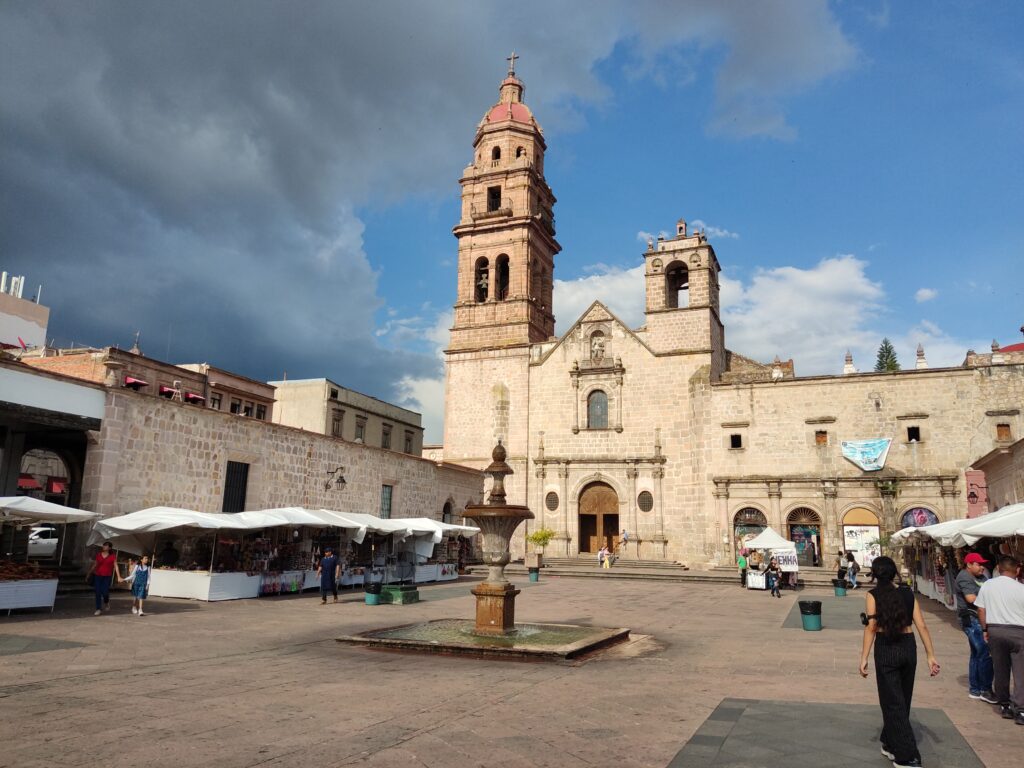
Museums in Morelia
There are several museums in Morelia, more than I can name here, but these are the ones that concentrate on the history of the region:
- Museo Regional Michoacano, Dr. Nicolás León Calderón (Michoacan Regional Museum)– This Baroque house displays regional historical artifacts from the pre-Hispanic era to 20th-century murals.
- Artisan Institute Michoacano focuses on the preservation of traditional folk art such as wood carvings and copper from various regions of Michoacán.
- Museo de Arte Colonial features masterpieces by Guatemalan and Mexican artists from the colonial era.
- Museo Casa Natal de Morelos, the birthplace of José María Morelos, one of Mexico’s independence heroes is now a library with books and memorabilia from 1821.
- Orquidario de Morelia (Orchid House) Orchid enthusiasts will love the Orquidario de Morelia with its vast collection of orchids from Central and South America.
SPECIAL MENTION:
Dulces Morelianos Calle Real (Patisserie Real Street)
First opened in 1840 as El Paraiso, today this museum/pastry shop café interactively shares its confectionary history. Real people (not animatronics) demonstrate their traditional sweet-making techniques. The museum is open every day of the year, but the restaurant is only open on Fridays, Saturdays, and Sundays. This is a great place to try local specialties such as uchepos, corundas, and Patzcuaro pasta “La Pacanda” (a thick ice cream that you’ll read more about below).
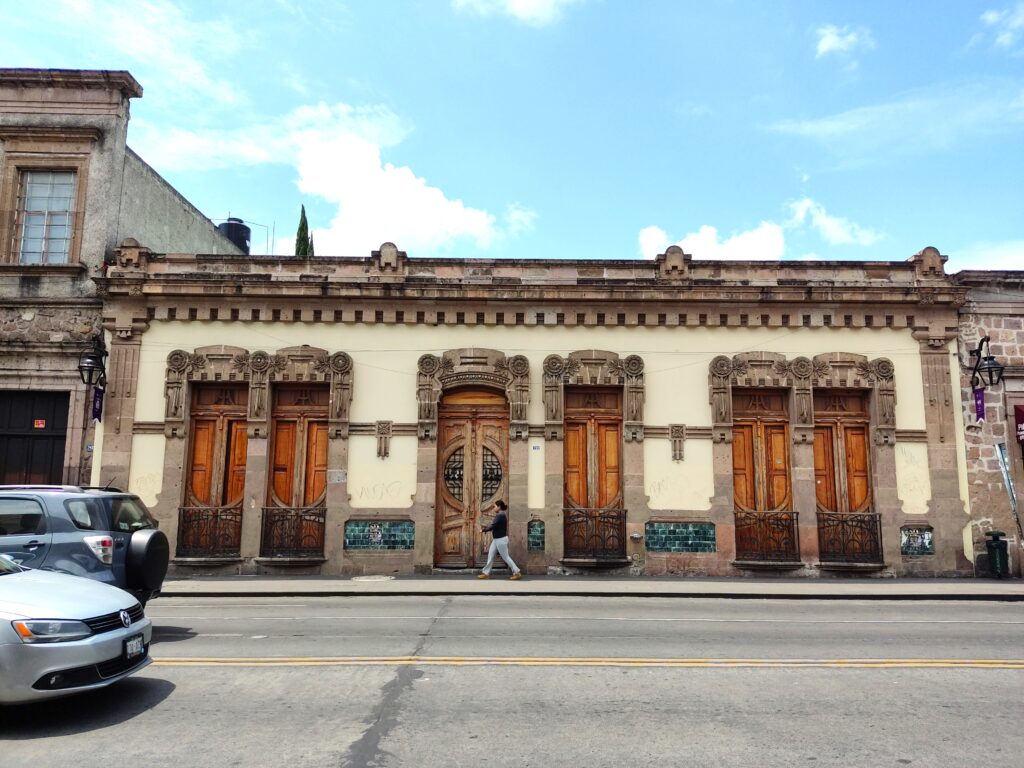
Parks, an Aqueduct, and the Alley of Romance
Bosque Cuauhtémoc
This large park is considered the “lung” of Morelia. Filled with bike paths, statues, and a duck pond, it’s a perfect place to relax and observe Mexican life. This park is so large that it also has museums and hospitals (which hopefully you won’t need). Spend the entire day visiting museums such as Museo de Arte Contemporáneo Alfredo Zalce (MACAZ), Museo de Historia Natural MUHNA, Planetario de Morelia (Planetarium), and Orquidario de Morelia (Orchid House).
Morelia Aqueduct
The aqueduct is an impressive feature of Morelia. At its inception, the aqueduct was 7 kilometers (4.35 miles) long. Today only a mile-long span of this engineering feat survives measuring 1810 meters and consists of 253 arches. Built to bring clean water to the city after a two-year drought, it also provided jobs to many of the indigenous people in the 18th century.
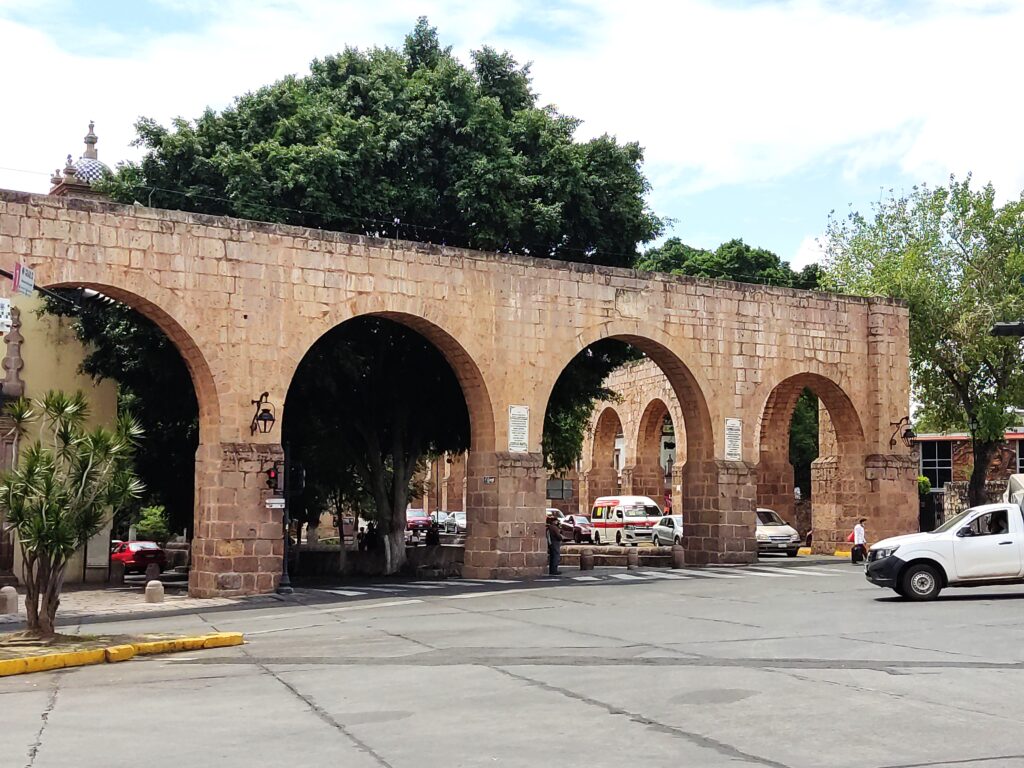
Tarascas Fountain
The original fountain was installed by the aqueduct in 1931. Unfortunately, it was removed and replaced by another fountain in 1967 because it was deemed “inappropriate”. In 1984, sculptor José Luis Padilla Retana was commissioned to recreate the original fountain. It features three bare-chested women holding a basket of regional fruit and offering it up to the sky as a sign of prosperity, abundance, and fertility. The original fountain was made of painted concrete, and the current fountain is made of bronze.
The women are thought to represent the Purépecha*** princesses Atzimba, Eréndira, and Tzetzangari. According to legend and Wikipedia, “Atzimba was exiled after she fell in love with a Spaniard explorer; Eréndira was a leader and a heroine who fought against the Spanish conquistadors, and Tzetzangari filled Lake Zirahuén with her tears.”
***The Purépecha people were also called Tarascos.
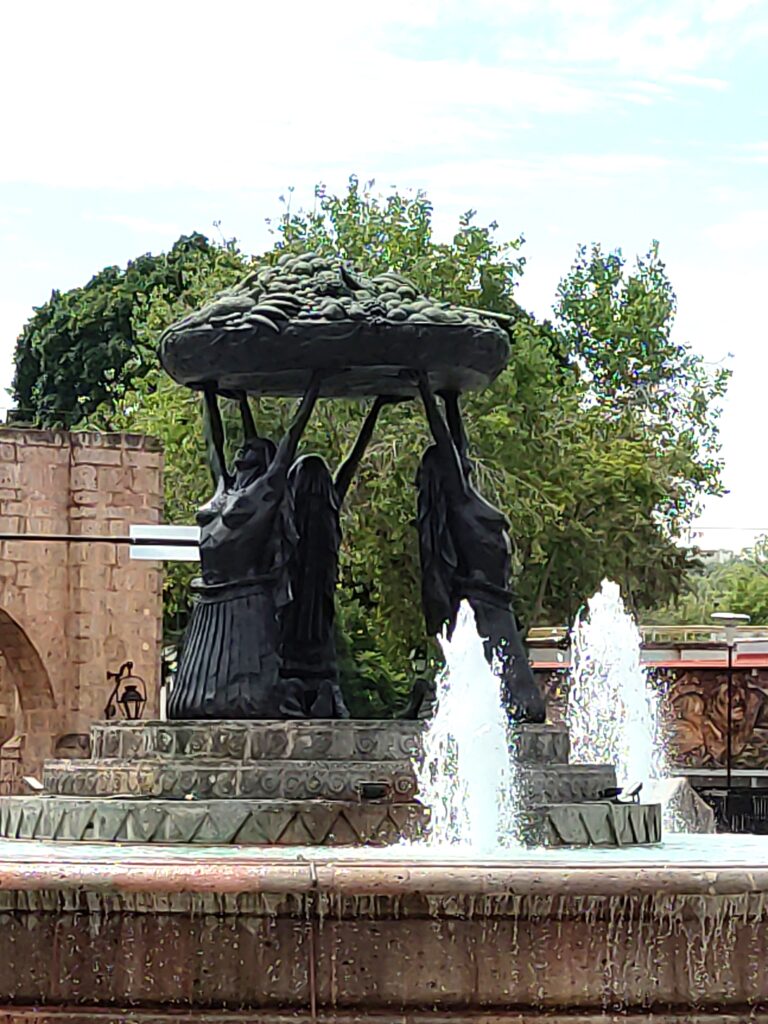
Jardín de las Rosas
This shaded block-long park is flanked by beautiful architecture on one side and outdoor cafes on the other. Fountains and statues adorn this simple little park in the middle of Morelia. Jardín de las Rosas is near the Palacio Clavijero, a cultural center and art museum.
Callejón del Romance
One of my favorite places in Morelia is Callejón del Romance (Alley of Romance). This picturesque walking street is lined with cafes, fountains, art galleries, and our favorite cocktail bar, Xaneque Cocktail Room. Walk slowly and look around. Hidden between the colorful bougainvillea are plaques with verses from the poem, “Romance of My City” by Lucas Ortiz.
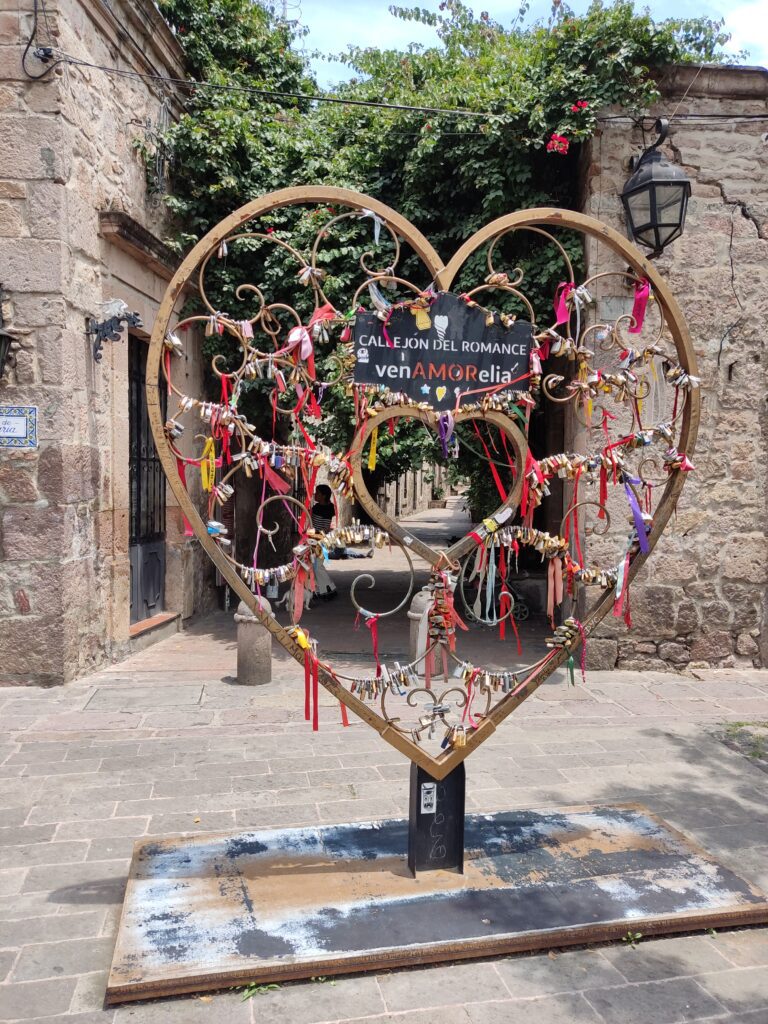
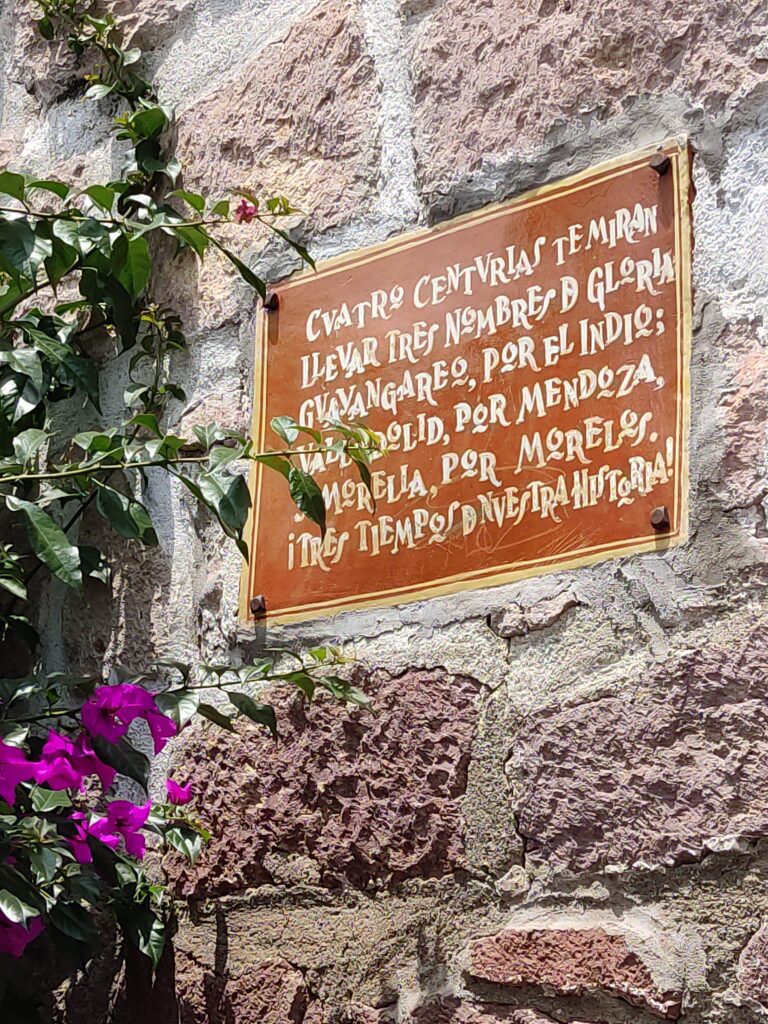
What to Eat in Morelia
If you ask a Mexican, many of them will say that the state of Michoacan has the best food (probably because a lot of it is grown here). For regional cuisine, these are the must-try foods:
Carnitas
They say the best carnitas come from Michoacan. We love carnitas, and the ones we had in Morelia were very tasty, but we have a bias for our local Santa Rosa Jauregui carnitas. Carnitas are pork meat slow-cooked in lard and served taco-style. We recommend getting carnitas from one of the food vendors in and around Plaza de San Agustin.
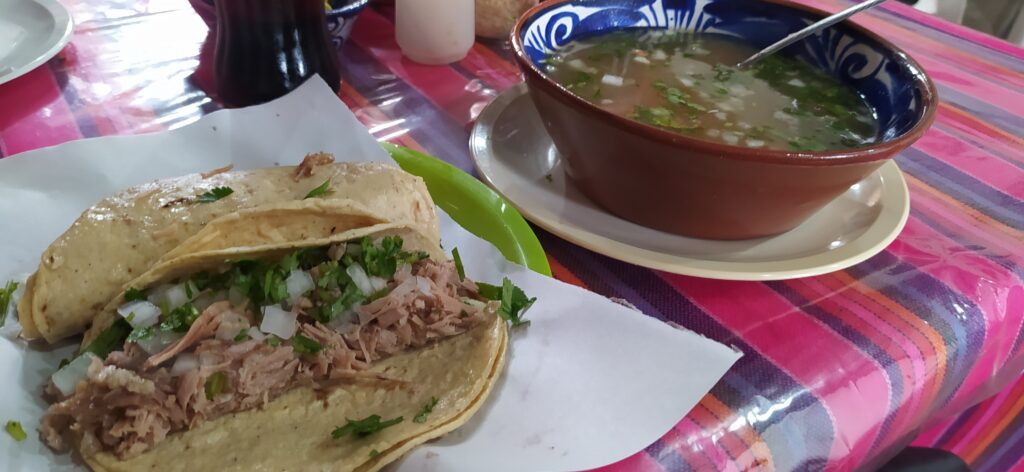
Corundas
A Corunda is a steamed tamale in the shape of a triangle. They may or may not contain something in the middle like bean paste. Typically, they are served with red salsa and sour cream.
Gaspachos
Not to be confused with the gazpachos (cold vegetable soup) from Spain, gaspachos in Mexico are a dessert made with chopped fruit, onions, orange juice, lime, chili, and queso cotija. It’s a very refreshing treat on a hot afternoon.
Stews
Michoacan cuisine is known to be hearty, and what’s heartier than a stew?
Sopa tarasca is a pinto bean soup flavored with tomatoes, onions, garlic, ancho peppers, herbs, and seasonings.
Atapakua is a stew made with pepitas (pumpkin seeds), ancho chilis, fresh corn, tomatoes, and garlic, and thickened with masa.
Churipo is spicier than atapakua and is traditionally prepared with beef, vegetables, corn, and chili peppers. These three stews are part of the Purépecha culture and have been around since before the Spanish arrived.
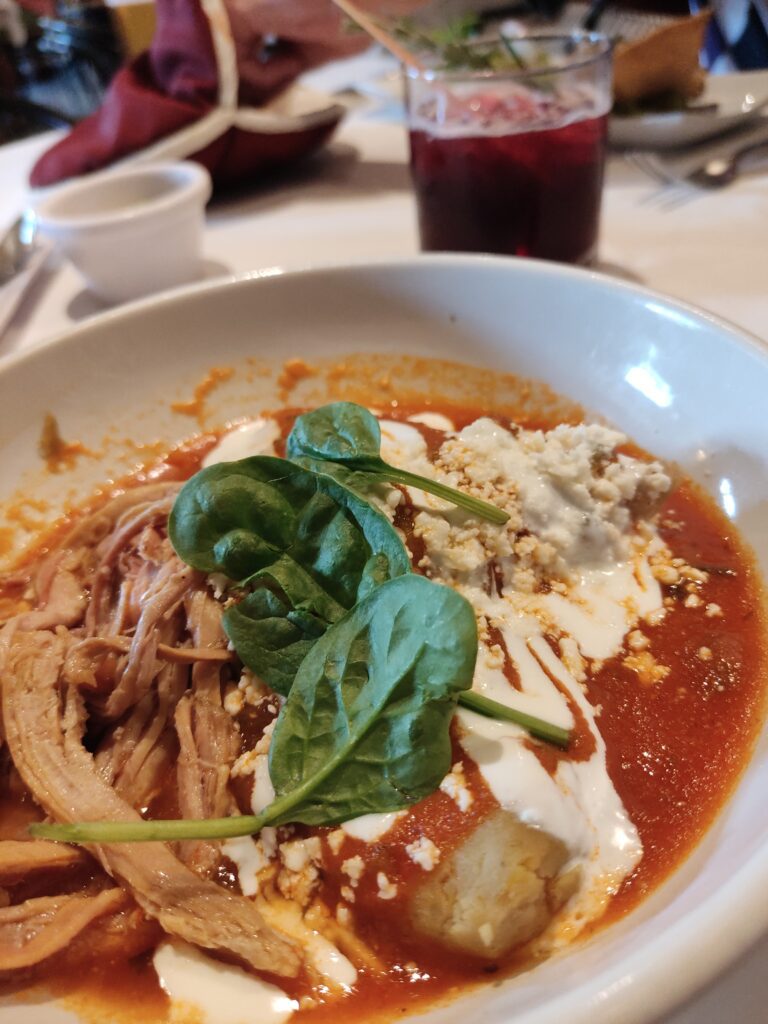
Ice Cream
La Michoacana ice cream shop is located all over the country but originally started in the small town of Tocumbo in Michoacan. Milk-based ice creams are super creamy, and they also serve nieves, ice cream made without milk. My favorite flavors are limon and mango.
Nieve de pasta literally means “paste ice cream”. It’s thick texture is almost custard-like. Natural nieve de pasta tastes like dulce de leche, but you can also get different flavors.
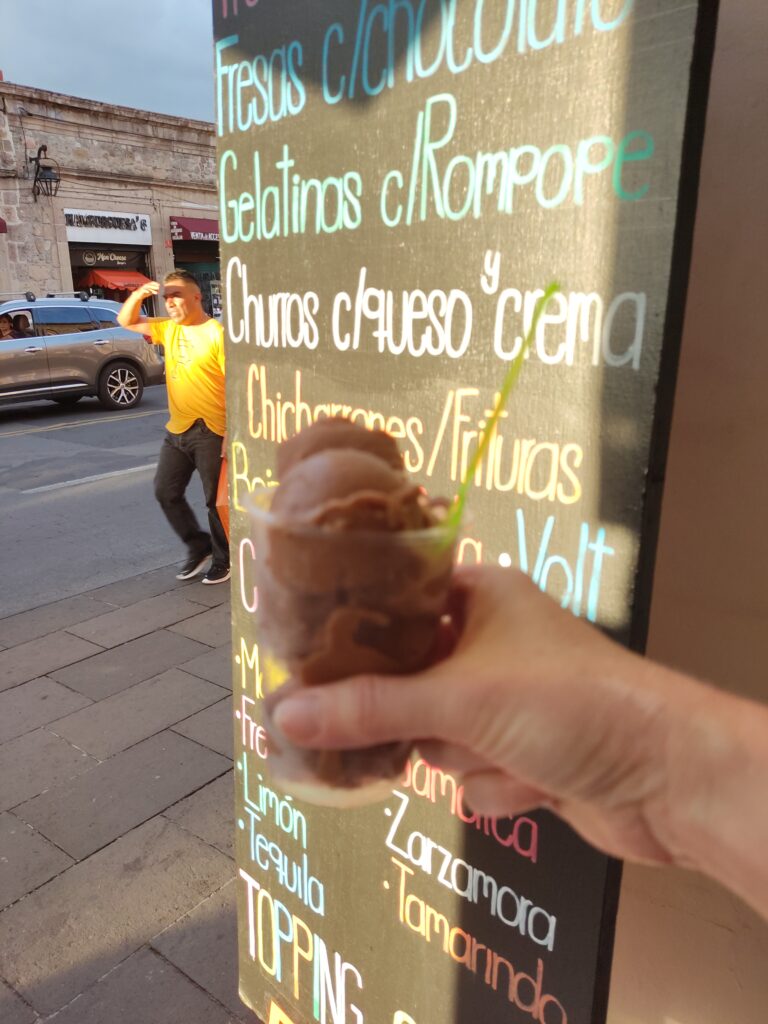
Where to Eat in Morelia
Breakfast
We had breakfast at Cafe Michelena, a bakery/bookstore next to Calle Abasolo. The outside porticos are gorgeous but sit inside to avoid the beggars. Their croissants are buttery, and the French toast was delicious. The bookstore has books ranging from history and cookbooks to travel. Some are offered in English.
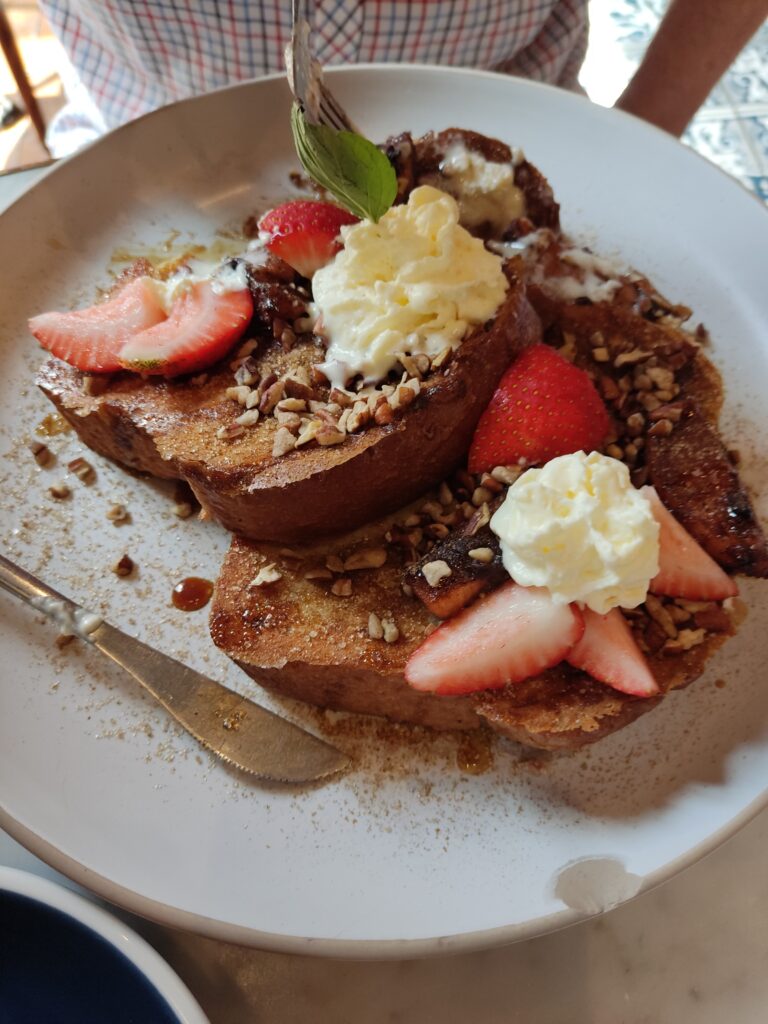
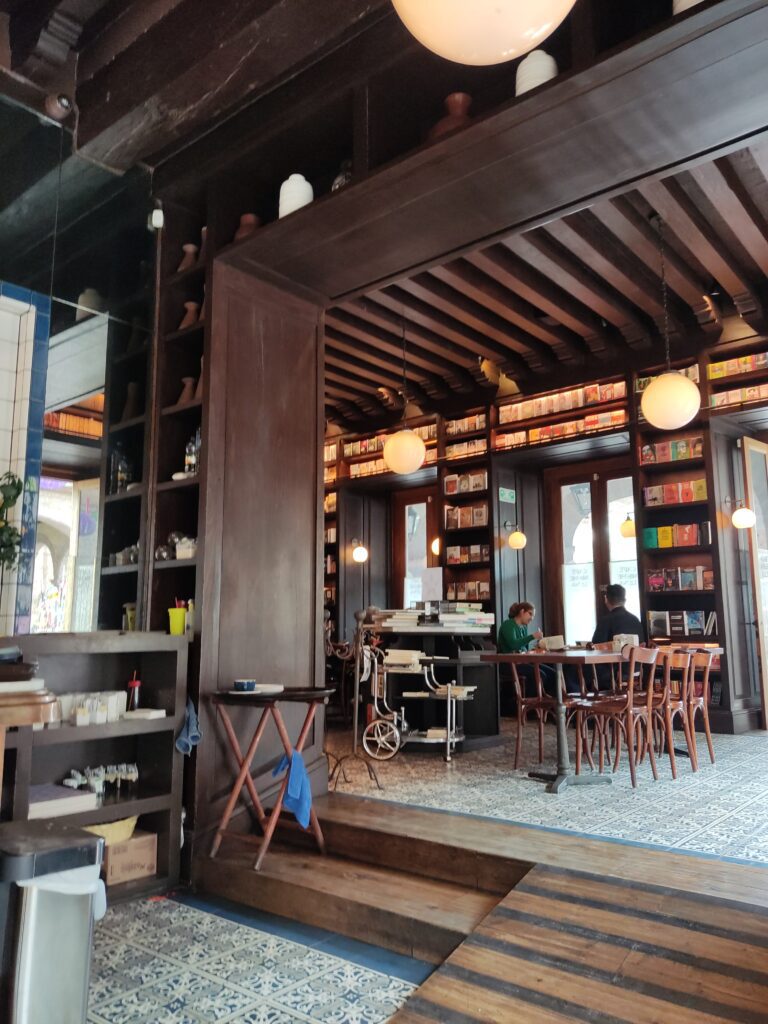
If you are visiting Morelia Friday, Saturday, or Sunday, have a late breakfast or lunch at Museo del Dulce Calle Real. The cafes across from Jardin de las Rosas are also a nice choice.
Lunch and Dinner
We had a fantastic lunch at La Conspiración de 1809, but the prices were high for rustic cuisine. That’s to be expected in the touristy part of the city. Walk a few minutes east towards the aqueduct and you’ll have more choices of restaurants and cuisines. Tata Mezcalería + Cocina has an excellent menu of food and mezcal and is a local hangout.
Morelia has many different cuisines to choose from if you don’t want Mexican food. We tried the rooftop Italian restaurant La Fontana, Piano Bar & Mezcalería. The wine list was well-priced, and my pasta dish was good. Our hotel also had excellent Italian dishes, and we passed by a Mongolian restaurant that we will try next time.
Street Food
For the best variety of street food, go to the outside perimeter of Plaza de San Agustin.
Cocktail Bars in Morelia
Morelia has a lively and diverse cocktail scene. From speakeasies to 90s dive bars, you won’t be disappointed with the variety of cocktail hangouts. If you enjoy mezcal, head to Tata Mezcalería + Cocina. They have a list of small producer mezcals from all 9 Denomination of Origin (D.O.) states. It’s fascinating to taste the different agaves in each of the mezcals (though I prefer mine mixed with fruit juice). For creative cocktails, Xaneque Cocktail Room in the Alley of Romance is not to be missed. Mexico City may have six of the World’s Best Bars, but Xaneque beats them all.
Other cocktail bars highly recommended are Watson Bar, The Boss Speakeasy, and The Nameless Hidden Bar.
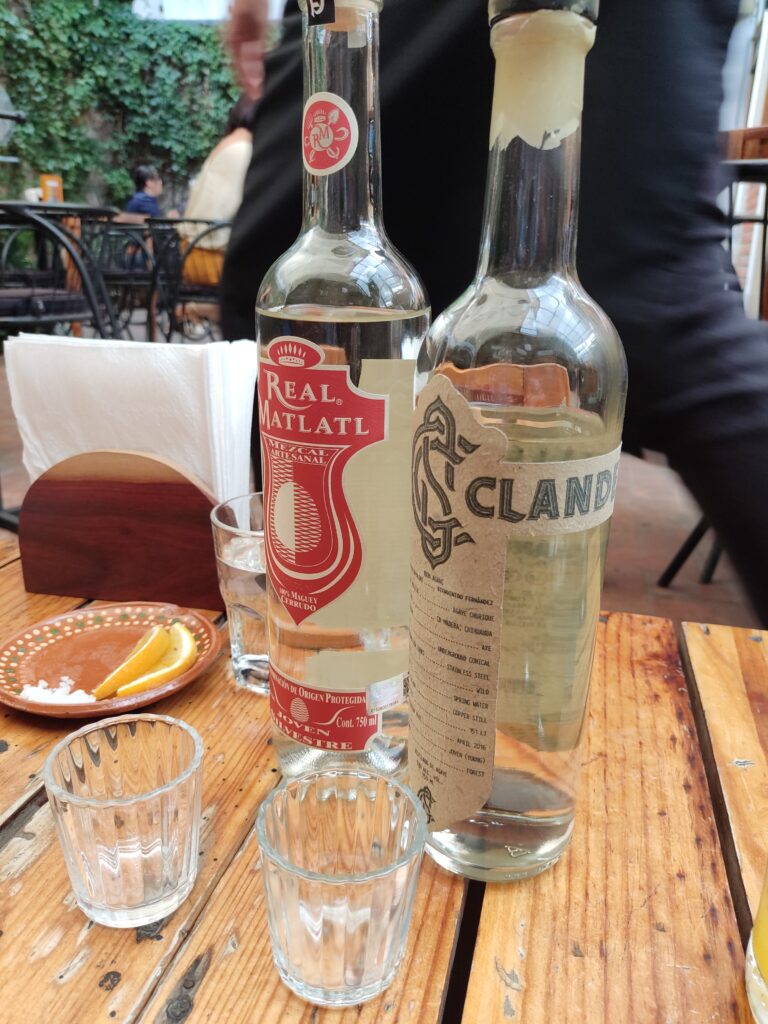
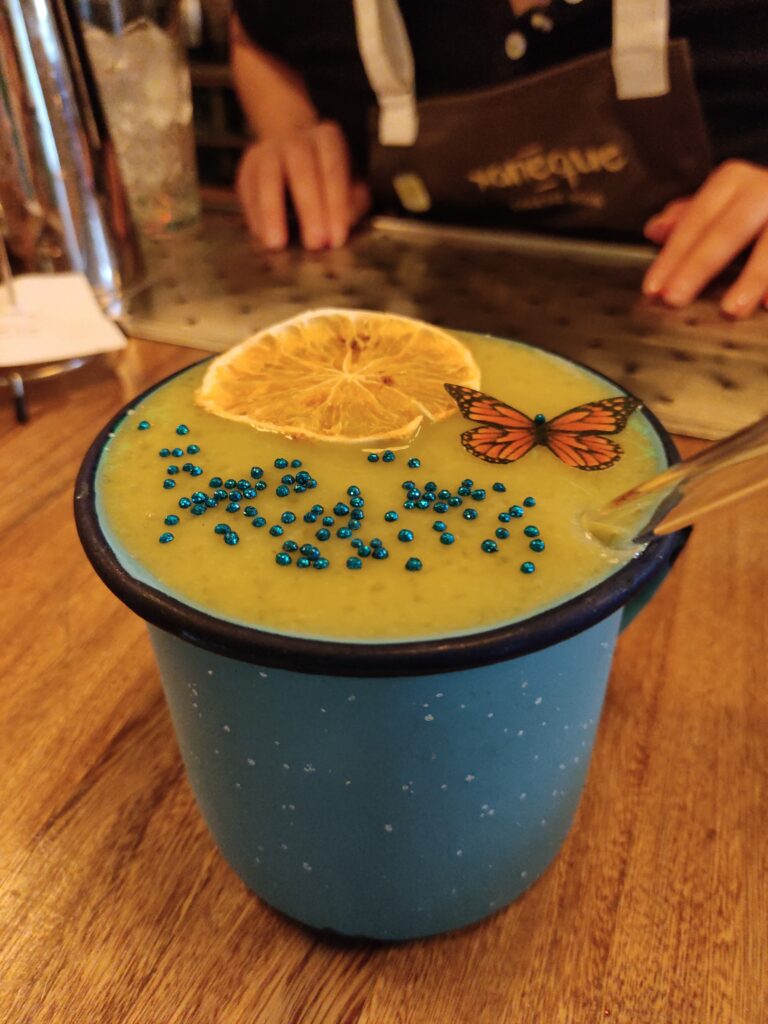
Day trips from Morelia
The state of Michoacan is frequently on the United States Travel Advisory list, but you can still safely travel to places just outside of Morelia. Take a bus or join a tour to see artisan villages and natural wonders nearby.
Patzcuaro
Patzcuaro is a pueblo mágico an hour’s drive from Morelia. With its cobblestoned streets, adobe houses, and balconies adorned with flowers, this adorable town is a photographer’s playground. Patzcuaro is one of the best places to see Day of the Dead celebrations. The villages along Lake Patzcuaro are decorated with marigold flower arches, altars, and a boat parade out to the islands where some cemeteries are located. Day of the Dead is November 2nd, but there are celebrations up to four days before that. Book your hotel in Patzcuaro early as this is a very popular time to visit.
Would you like to visit three pueblos magicos in one day?
Visit Patzcuaro, Tzintzuntzan, and Santa Clara del Cobre on a full-day tour.
Tzintzuntzan means “place of the hummingbirds” in the Purépecha language. It was once the capital of the Tarascan empire. The San Francisco de Tzintzuntzan Convent was the first Franciscan convent built in Michoacan to convert the indigenous people to Christianity. Today, the town is known for its artisanal basket and weaving production.
The town of Santa Clara del Cobre has been working with copper since the pre-Hispanic era. 82% of the town is employed in making copper from jewelry and utensils to large cooking pots. If you visit during August or September, check the dates for the Feria Nacional y Concurso del Cobre Martillado (National Festival and Competition of Hammered Copper).
Festivals in Morelia
Music and art are at the heart of this university city. Festival Internacional de Guitarra FIG celebrates the guitar and its players in September, and Festival Internacional de Cine de Morelia (FICM) promotes the new talents of Mexican cinema in October. In November, Day of the Dead festivities take over the at the beginning of the month, and concert music fills the air later in the month during the Festival de Música de Morelia 2024.
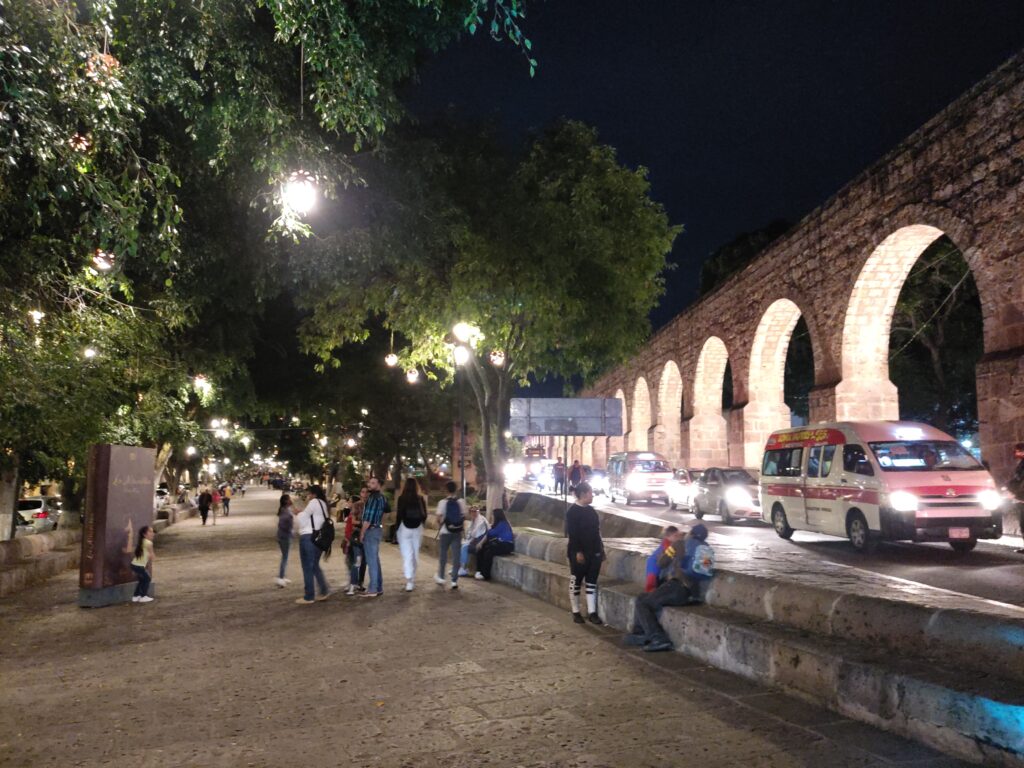
Where is Morelia located?
Morelia is located in Central Mexico in the north-central part of the state of Michoacan. This area is very green and hilly and sits at an elevation of 6400 feet (1950 meters).
Flights to Morelia
Luckily, Morelia has a small international airport that connects to several different cities in the United States. Direct flights to/from Morelia (MLM) include:
Chicago (MDW and ORD), Dallas (DFW), Houston (IAH), Los Angeles (LAX), San Jose (SJC), and Oakland (OAK).
Domestic connections include: Monterrey (MTY), Mexico City (MEX and NLU), Tijuana (TIJ), Cancun (CUN), and Mexico City (MEX)
Check Expedia for Flight and Hotel Packages to Morelia.
Getting to Morelia by Car or Bus
Morelia is a few hours’ drive from many major cities in Mexico. The highways are good if you want to drive yourself, but we prefer someone else to do the driving, so we like taking the bus. Primera Plus and ETN are both luxury coaches with bathrooms and entertainment that connect to Morelia from major cities. It can take up to an extra hour by bus, but we don’t have to worry about a bathroom or parking when we reach our destination.
Drive time to Morelia from:
- Mexico City- 4 hours
- Queretaro- 2.5 hours
- Guanajuato- 3 hours
- Guadalajara- 3.5 hours
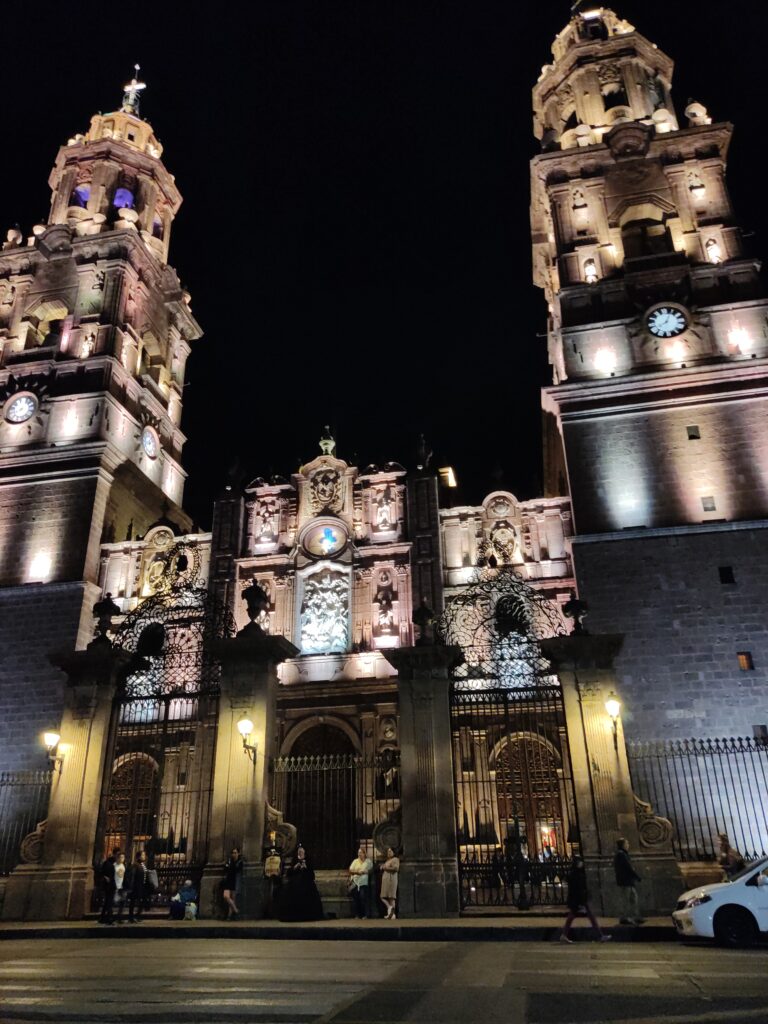
Where to Stay in Morelia
The most ideal location to stay in Morelia is around the historical center. It’s easy to walk around to see the attractions with plenty of food options and inventive cocktail bars. If you are a light sleeper and firework noise at all hours bothers you, the Hotel Herencia By Hosting House, Hotel Boutique Casa Madero, and Hotel De La Soledad are supposedly soundproof.
Soundproof Hotels in Morelia
Hotel Herencia By Hosting House, Hotel Boutique Casa Madero, and Hotel De La Soledad
When we visited Morelia, we used hotel points with Fiesta Americana and stayed at Gamma Morelia Vista Bella. Our hotel was a 15-minute drive outside the center and past the zoo in a quiet residential area. The rooms and bathrooms were spacious, and the hotel had an excellent Italian restaurant with a good wine list.
What is the Weather Like in Morelia?
The best times to visit Morelia are October through January. The worst time of year to visit Morelia is between February and June when temperatures are over 33 C (91 F). Morelia receives most of its rainfall from June to September which lowers the temperatures significantly, especially at night. From July to October, the day temperatures are between 25-29 C (77-85 F) with night temperatures around 14 C (57 F).
How Much Time Do I Need in Morelia?
The historical center is compact, and you can see it easily in one or two days. If you plan to visit museums and want to tour other areas close by, I recommend a minimum of 3 days. In Mexico, there’s no need to rush. Take your time, enjoy a slower pace, and don’t forget to try a nieve de pasta.
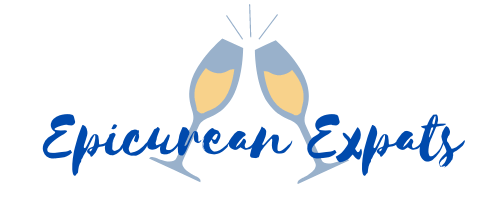
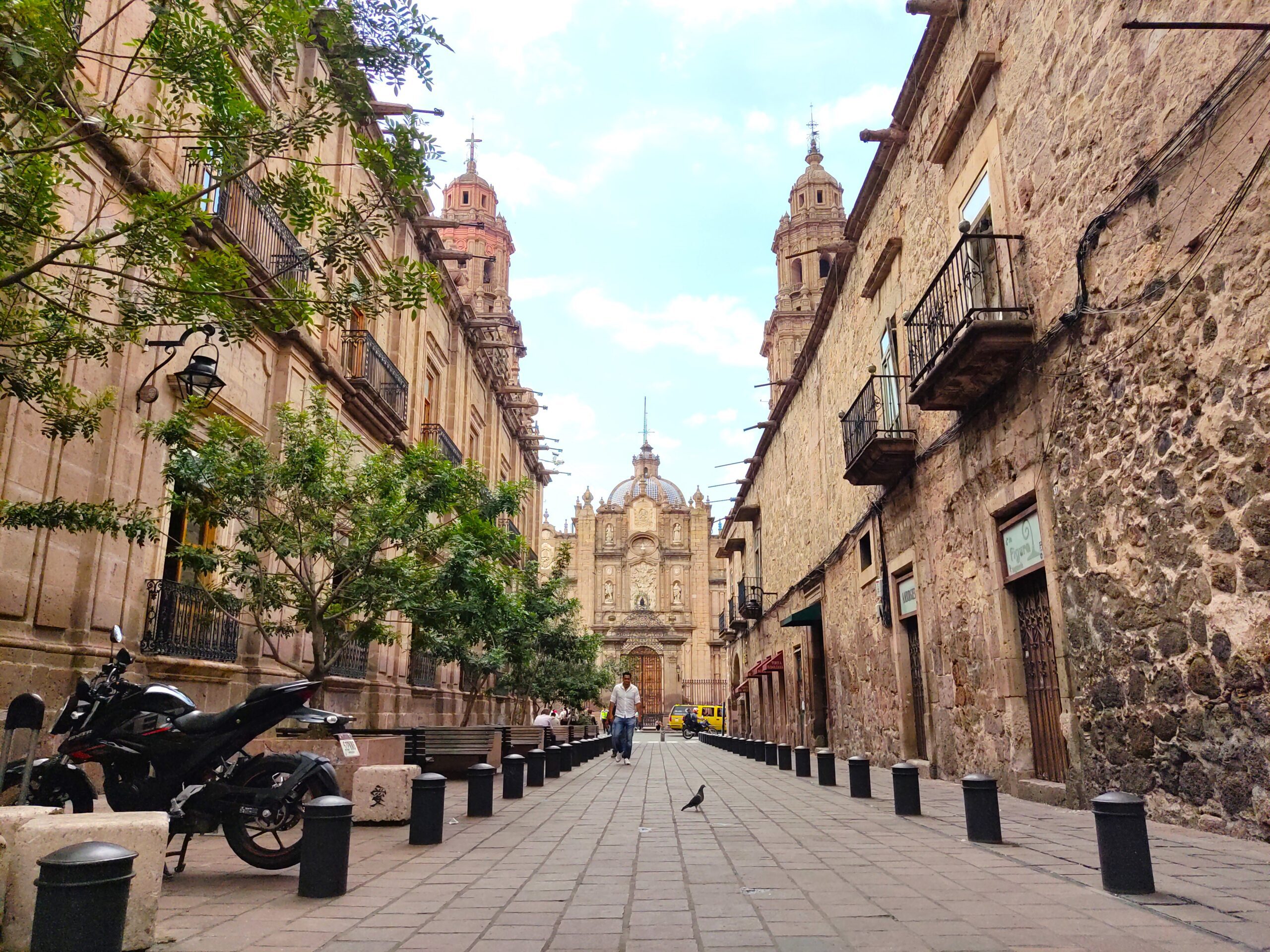
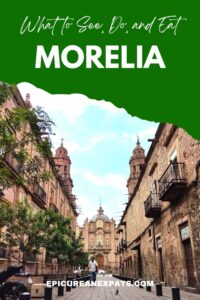
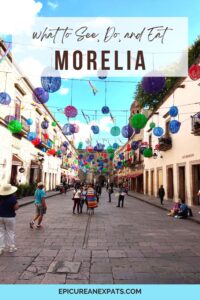
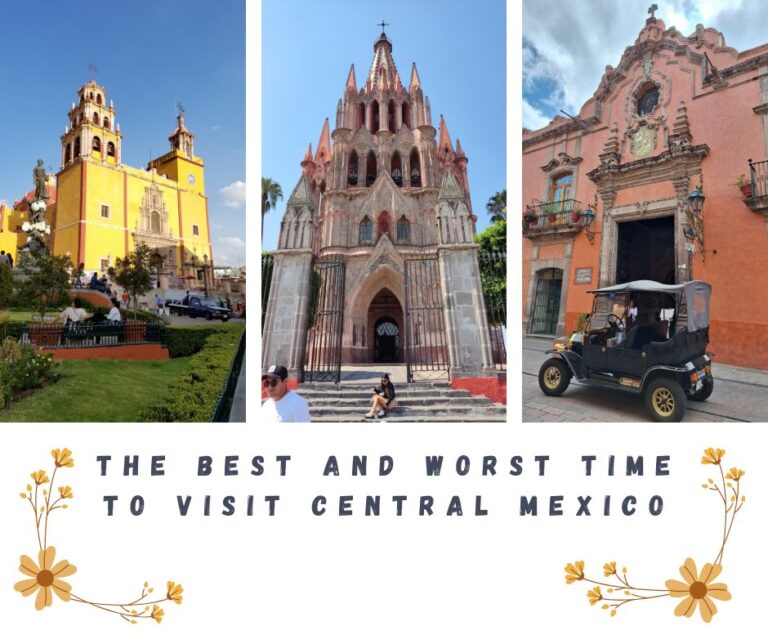
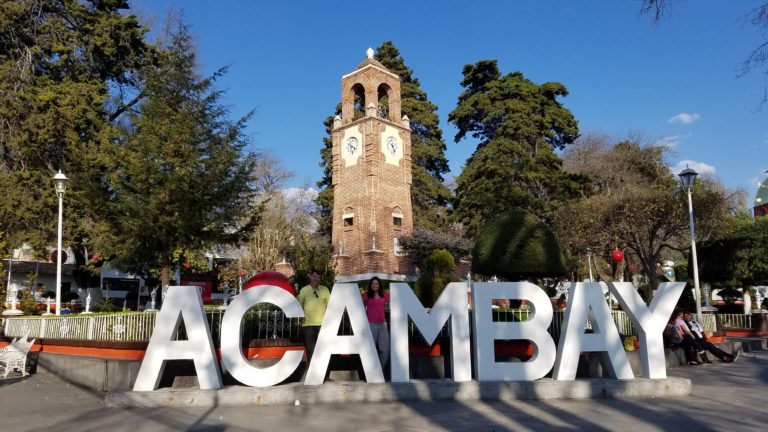
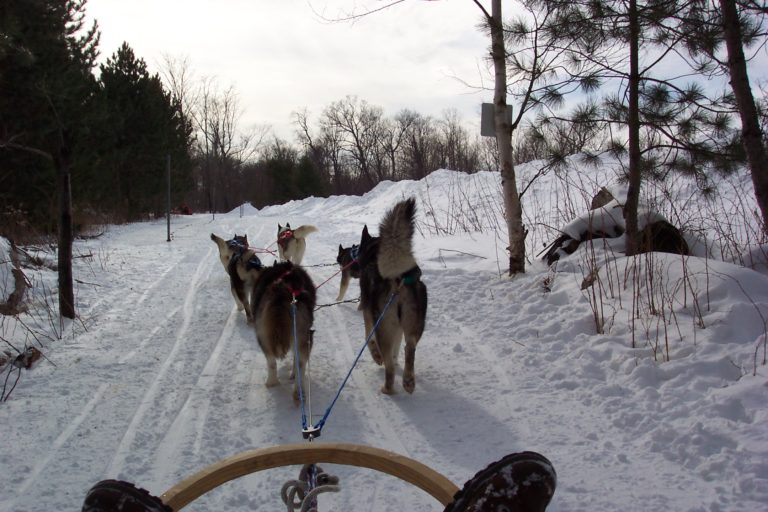
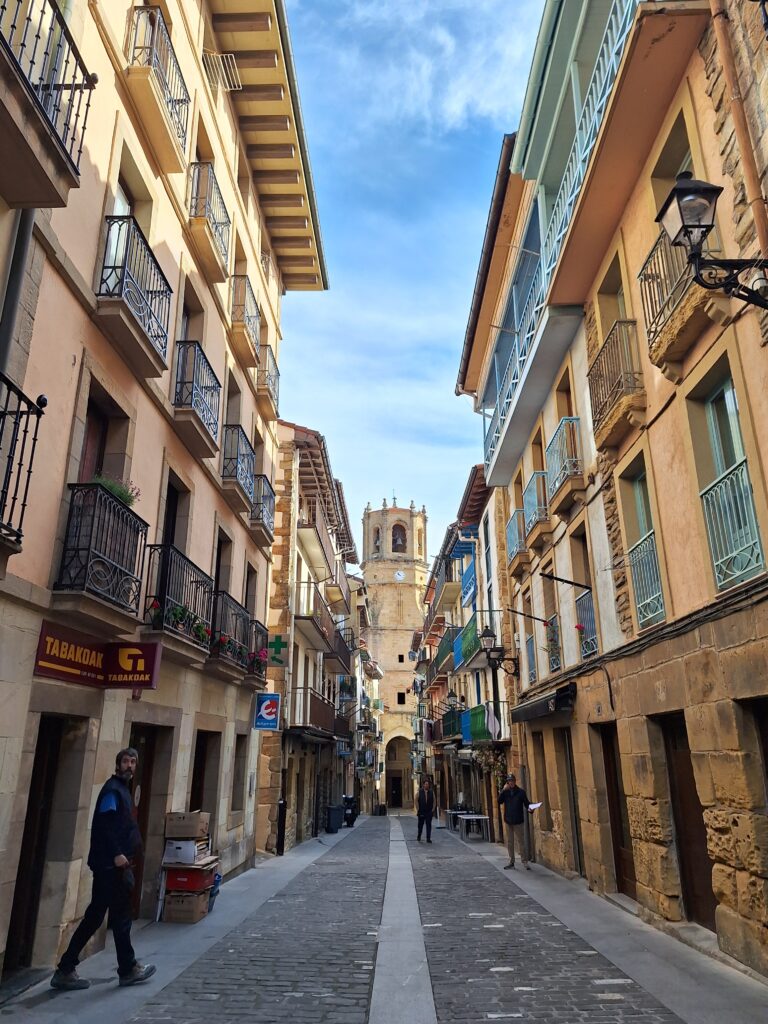
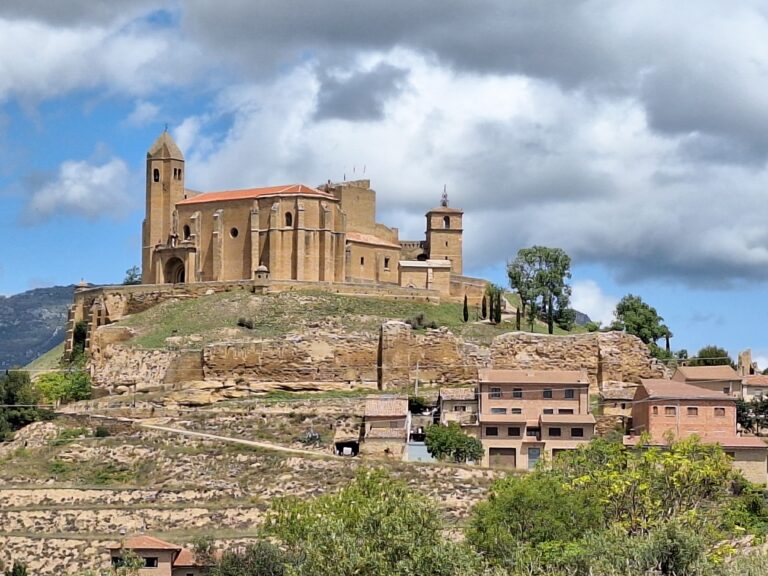
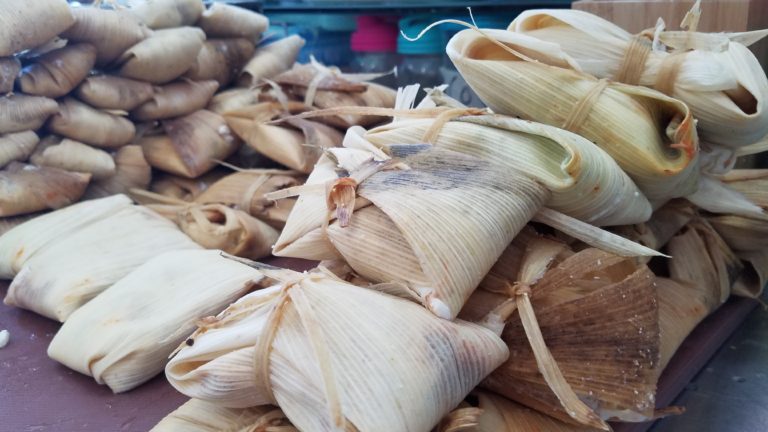
My husband and I spent a month in Guanajuato last August trying to escape the Texas heat. We decided to take a quick bus trip and check out Morelia. It was great! Beautiful city, great food, nice people. We would love to go back and stay longer.
Isn’t it amazing how Central Mexico is so much cooler than Texas in August? Guanajuato and Morelia are both beautiful cities! Glad you got a chance to spend time in each!